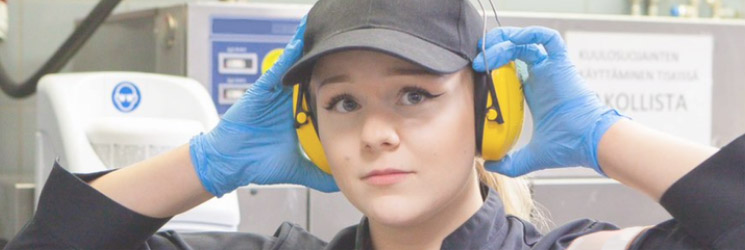

Working conditions
Radon
Radon is an odourless, tasteless and colourless radioactive noble gas that is continually being generated in subsurface rock formations and soil. Exposure to radon gas can increase the risk of lung cancer.
General information on topic
Radon levels can be measured to study indoor air quality. Radioactivity is measured in becquerel (Bq). One becquerel is defined as the activity of a quantity of radioactive material in which one nucleus decays per second. Radon concentration in the atmosphere is usually measured in becquerel per cubic meter (Bq/m3).
It is the employer’s responsibility to measure radon levels in the workplace if there is reason to believe that the applicable reference values could be exceeded. Employers’ compliance with safety regulations in respect of exposure to radon radiation can be verified in the course of occupational safety and health inspections.
Reference values for radon levels in the workplace
The Finnish Radiation Decree defines reference values for radon levels in the workplace. Employees who work regular hours (more than 600 hours per year) must not be exposed to radon levels in excess of 300 Bq/m3 on average per year. The same reference value also applies to schools, nurseries and other public buildings.
High radon levels can be anticipated on the basis of previous radon measurements. The Finnish Radiation and Nuclear Safety Authority keeps a list of local authorities where radon levels must be measured at all workplaces (due to at least 10 % of previously measured annual averages being above the reference value). Legislative reforms are due to extend the obligation to measure radon levels to several new local authorities or specific postcodes.
Radon levels also need to be measured in all buildings that are located on gravelly ridges or in other areas dominated by air-permeable gravelly or sandy soil as well as in all regularly occupied underground workspaces. Measurements usually do not need to be taken on the upper floors of buildings.
Measurements must be taken in all buildings of the workplace
Radon levels are measured using so-called passive radon dosimeters, which must be left in place for a period of at least two months. Every workspace must have its own dosimeter. The radon measurement period runs from the beginning of September until the end of May each year.
In large properties, measurements must be taken from several different rooms. Up to two dosimeters are usually enough in open-plan industrial buildings, while one dosimeter per 200 square metres should be used in offices.
Advice from the Finnish Radiation and Nuclear Safety Authority
The employer must report the radon measurements performed at the workplace to the Finnish Radiation and Nuclear Safety Authority (STUK). The reporting is made via STUK's electronic service (STUK eGovernance). The measurements ordered from STUK don't have to be notified.
The Radiation and Nuclear Safety Authority takes over the monitoring of any buildings where the reference value is exceeded and has the power to order employers to lower radon levels or carry out further tests.
More information about radon and measuring radon radiation levels is available on the Radiation and Nuclear Safety Authority’s website:
Legislation
- Section 155 – Determination of radon levels in the workplace

